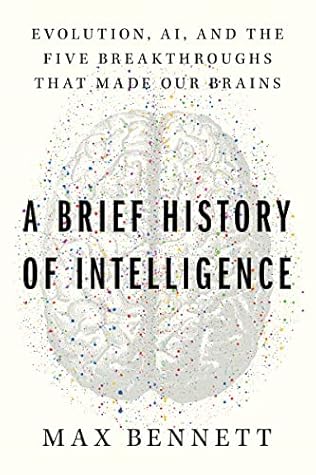More on this book
Community
Kindle Notes & Highlights
Read between
March 17 - March 24, 2024
within a single cubic millimeter (the width of a single letter on a penny), there are over one billion connections.
“Nothing in biology makes sense except in the light of evolution.”
call abiogenesis: the process by which nonbiological matter (abio) is converted into life (genesis).
The fungal strategy was, by some measures, more successful than the animals’—by biomass, there is about six times more fungus on Earth than animals.
Fungi are currently, and likely have always been, Earth’s garbage collectors.
Gastrulation, neurons, and muscles are the three inseparable features that bind all animals together and separate animals from all other kingdoms of life.
Adrian himself noted the similarity between neural spikes and Morse code.
This was Adrian’s second discovery, what is now known as rate coding. The idea is that neurons encode information in the rate that they fire spikes, not in the shape or magnitude of the spike itself.
photosensitive neurons encode contrast in their firing rate; smell-sensitive neurons encode concentration in their firing rate.
these natural variables have a massively larger range than can be encoded in the firing rate of a neuron.
luminance of light is varying astronomically all around you. The amount of light entering your eyes when you look at a white piece of paper is one million times greater if you are in sunlight than if you are in moonlight.*
This is not just a feature of light; all sensory modalities, from smell to touch to sound, require the discrimination of hugely varying natural variables.
it is simply impossible for a neuron to fire faster than around five hundred spikes per second. This means that a neuron needs to encode a range of natural variables that can vary by a factor of over a million all within a firing rate ranging only from
“squishing problem”: neurons have to squish this huge range of natural variables into a comparably minuscule range of firing rates.
wide range of natural variables in such a small range of firing rates without losing a huge amount of precision.
Neurons do not have a fixed relationship between natural variables and firing rates.
Instead, neurons are always adapting their firing rates to their environment; they are constantly remapping the relationship between variables in the natural world and the language of firing rates.
This applies in many neurons throughout the brains of animals—the stronger the stimuli, the greater the change in the neural threshold for spiking.
In some sense, neurons are more a measurement of relative changes in stimulus strengths, signaling how much the strength of a stimulus changed relative to its baseline as opposed to signaling the absolute value of the stimulus.
The stronger a stimulus is, the more strength will be required to get the neuron to respond similarly next time.
sehnsucht, that roughly translates to the emotion of wanting a different life;
The affective states of humans
In the nematode, dopamine is released when food is detected around the worm, whereas serotonin is released when food is detected inside the worm.
If dopamine is the something-good-is-nearby chemical, then serotonin is the something-good-is-actually-happening chemical. Dopamine drives the hunt for food; serotonin drives the enjoyment of it once it is being eaten.
3.4: Role of neuromodulators in affective states of first bilaterians
basic dichotomy between dopamine and serotonin
Berridge proved that dopamine is less about liking things and more about wanting things.
As early as the first bilaterians, dopamine was a signal for the anticipation of a future good thing, not the signal for the good thing itself.
The Centers for Disease Control (CDC) has even devised a term for this: deaths of despair.
Adrenaline not only triggers the behavioral repertoire of escape; it also turns off a swath of energy-consuming activities to divert energetic resources to muscles.
These relief-and-recover chemicals like opioids do
Opioids also keep certain luxury functions, such as reproductive activities, turned off until the relief-and-recover process is done; this is why opioids decrease sex drive.
nematode starved for only twelve hours will eat thirty times more food than their normally hungry peers.
Chronic stress isn’t all that different from acute stress; stress hormones and opioids remain elevated,
But chronic stress differs from acute stress in at least one important way: it turns off arousal and motivation.
The first was the arousal question: Do I want to expend energy moving or not? The second was the valence question: Do I want to stay in this location or leave this location?
While learning in modern AI systems is not continual, learning in biological brains has always been continual.
spontaneous recovery: broken associations are rapidly suppressed but not, in fact, unlearned; given enough time, they reemerge.
reacquisition: old extinguished associations are reacquired faster than entirely new associations.
The Original Four Tricks for Tackling the Credit Assignment Problem
Hebbian learning is often referred to as the rule that “neurons that fire together wire together.”
Learning was not the core function of the first brain; it was merely a feature,


